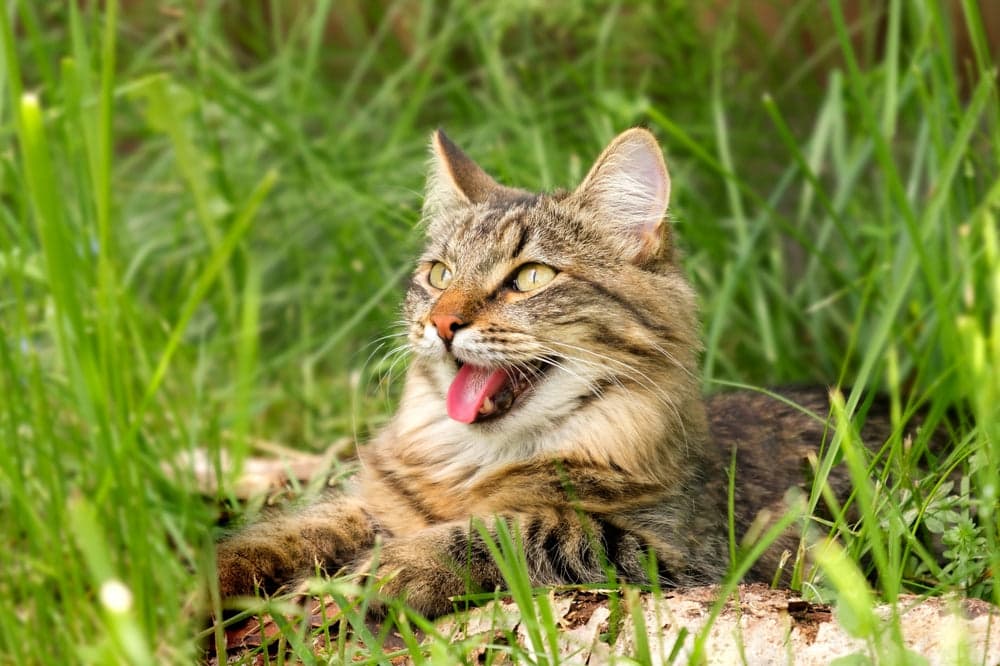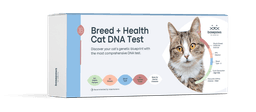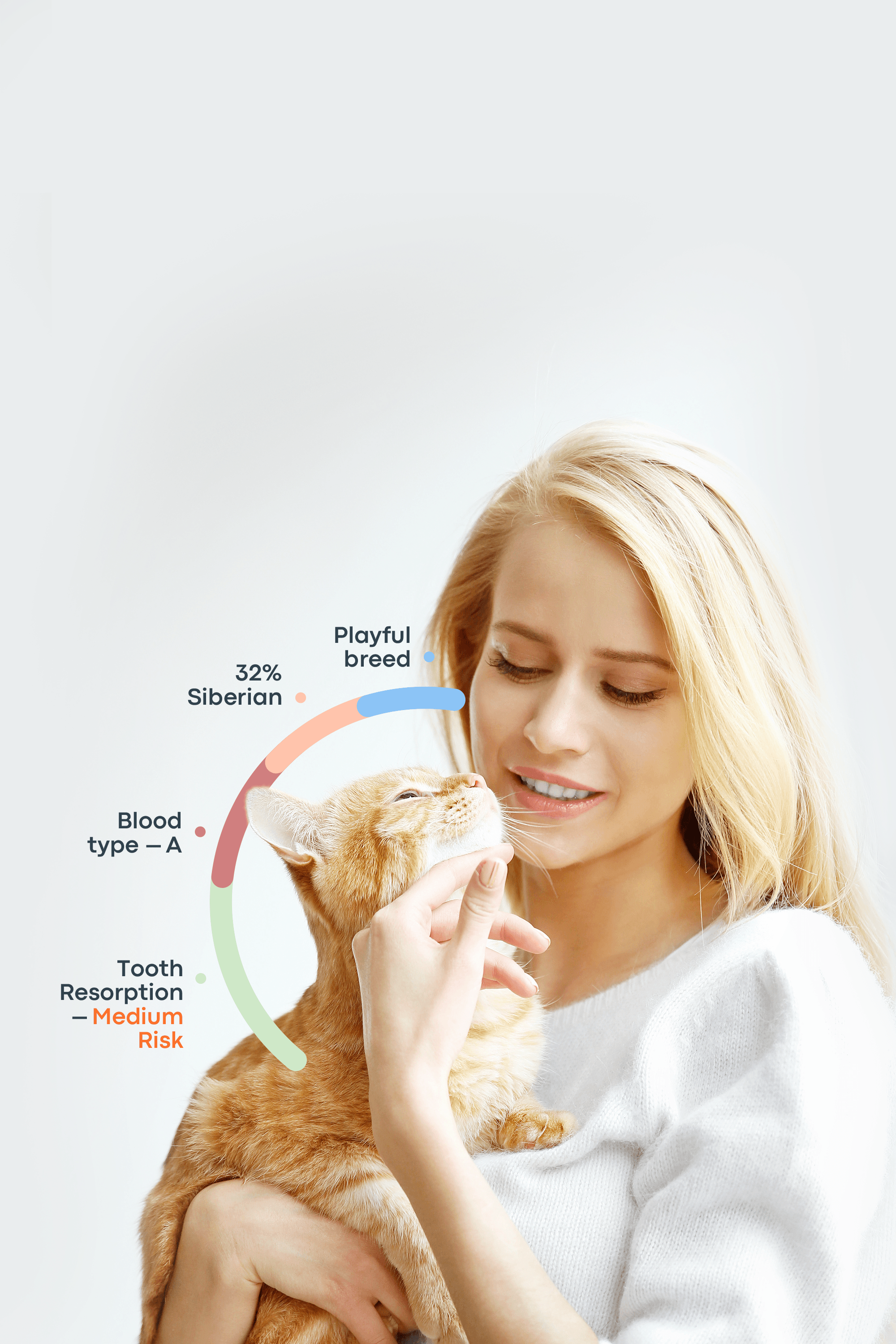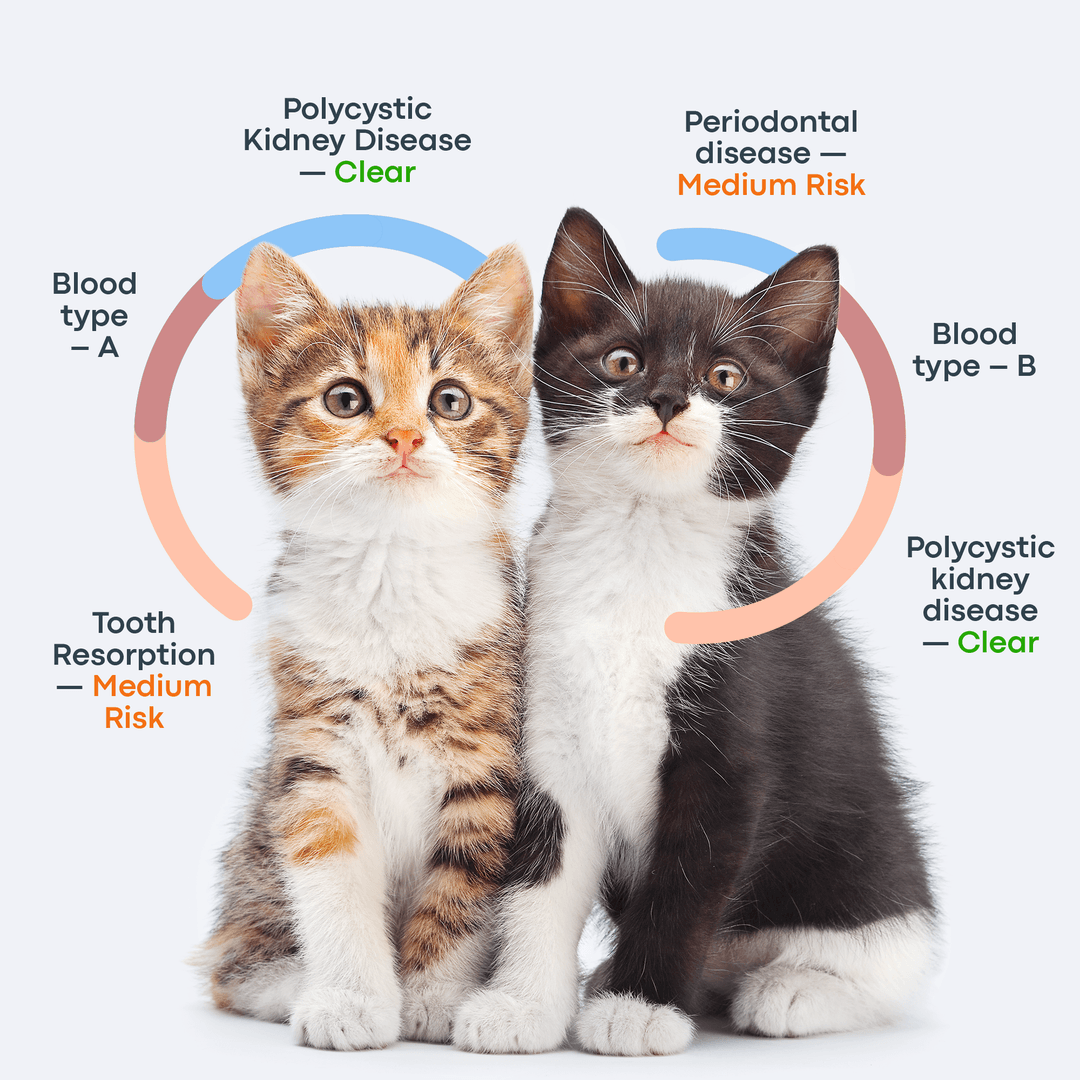Panting in cats is an unusual behavior that can catch pet parents off guard. Unlike dogs, cats rarely pant – so when it happens, it’s worth paying attention. While panting can be harmless in certain situations, such as after intense play, it may also signal underlying stress, overheating, or a more serious health issue. Understanding when cat panting is normal and when it’s a cause for concern is essential. In this guide, we’ll explore the possible reasons behind cat panting and when it’s time to call the vet.
What Does Cat Panting Look Like?
Seeing your cat open-mouth breathing or seeing your cat panting after play can be concerning if you don’t know what you’re looking at, so let’s break it down.
Visual and Behavioral Signs
Looking at a cat who’s panting, they will usually have an open mouth, with their tongue out or against their bottom teeth, taking fast, shallow breaths. These breaths can be quiet or sound like a dog panting. Alongside this, they may also be wide-eyed, with anxious body language, and may be crouching or pacing. If you are concerned, take a picture or video to show your vet (but this shouldn’t take priority over getting the animal seen to). Panting shouldn’t be confused with the Flehmen response, which is when a cat will smell something for a while before pulling back with an open-mouth expression (lovingly and colloquially called “stink face”).
The Flehmen response allows the cat to use the Jacobson's organ (also known as the vomeronasal organ) on the top of their mouth to detect more information than usual, often about other animals. While the facial expression can be similar to panting, the Flehmen response lasts a very short time and does not come with rapid breathing.
When Is Cat Panting Considered Normal?
While there are instances where cat panting is concerning, there are also times when it’s normal or even expected!
After Intense Exercise or Play
Cats, especially indoor cats, need a lot of exercise and play. They are small predators designed to chase and ambush prey. However, that doesn’t mean they’re invulnerable. After a hard and fast play session, cats might pant for a minute or two to help their bodies cool down and recover. Kittens are more prone to this behavior as they have fewer energy reserves to call upon after a good play session.

Heat and Temperature Regulation
Sometimes a heavy-breathing cat is a hot cat! Cats don’t sweat like we do, only having sweat glands on hairless areas like their paw pads. Your cat breathing fast is one way they can cool themselves off. If it’s hot where you are and you’re worried about your cat, you can check on them by taking their temperature with a rectal thermometer, looking out for drooling or sweaty paw pads, and seeing if their tongue and gums are red or pale.
Temporary Stress (e.g., car ride, vet visit)
You might sometimes notice your cat panting in cars or see your cat breathing heavy at the vet. This is a part of the activation of the hypothalamic-pituitary-adrenal axis (HPA axis), which is how their body (and ours) produces cortisol, and one of the physical signs of this is fast breathing. The panting should stop 5-10 minutes after the stressful event has passed. Keep an eye out for symptoms like changes in their eating or sleeping patterns and changes in their grooming, as these can all be more serious signs of stress that need the help of a vet or behaviorist to fix.
Your cat is likely okay if:
They stop panting after the event has passed.
They take 5–10 minutes to calm down and then stop panting.
They stop panting during the event.
When Is Cat Panting an Emergency?
While not all forms of panting are a problem, some are. Here are some signs to look out for and a quick guide on when to call the vet.
Warning Signs of Emergency Panting in Cats
Sign | What It Might Indicate | Recommended Action |
Pale, blue, gray, or yellow gums | Poor oxygenation, anemia, liver issues | Call the vet immediately |
Panting longer than 5 minutes | Ongoing distress, possible medical emergency | Monitor briefly, then act |
Collapse or extreme lethargy | Heart failure, trauma, systemic illness | Emergency vet visit |
Gagging, yowling, or vomiting | Foreign object, pain, respiratory crisis | Seek urgent care |
Belly rising more than chest | Labored breathing, fluid buildup | Emergency situation |
Noisy, wheezing, or raspy breathing | Asthma, infection, airway obstruction | Contact vet right away |
Call the vet immediately if:
Your cat has pale, white, blue, or yellow gums.
Your cat is having difficulty breathing.
You observe other concerning symptoms such as lethargy, loss of appetite, fever, coughing, or wheezing.
Medical Causes of Cat Panting (With Symptoms)
Here are the most common medical causes of cat heavy breathing.
Condition | Key Symptoms | Urgency |
Asthma | Coughing, wheezing, open-mouth breathing | Urgent |
Heart Disease / CHF | Labored breathing, lethargy, fluid in chest | Emergency |
Heartworms | Sudden panting, collapse, coughing | Emergency |
Anemia | Pale gums, weakness, rapid breathing | Urgent |
Respiratory Infection / Pneumonia | Nasal discharge, sneezing, noisy breathing | Needs vet exam |
Foreign Object | Gagging, pawing at mouth, drooling | Emergency |
Trauma / Pain | Limping, hiding, panting with no exertion | Needs evaluation |
Asthma
Asthma is a respiratory illness that affects an animal's ability to breathe normally. Like in humans, it can be triggered by pollen, dust, and exercise. Your vet can prescribe corticosteroids and bronchodilators that come in the form of inhalers or oral medication for your cat to be given daily or after a trigger. Most cats do not enjoy their medication, so make sure to have some treats on hand so you can gain their forgiveness later!
Heart Disease and Congestive Heart Failure
Heart disease and heart failure can cause panting. When a cat's heart begins to fail, fluid can build up in their abdomen, putting pressure on their diaphragm and lungs. This pressure is why cats start to pant – and to us, it can come about suddenly. Cats can have this fluid drained while receiving other treatments to ease the pressure.
Heartworms

Heartworms are parasites that live in the feline heart and the blood vessels around it. It’s not a pleasant thought for anyone, let alone a worried pet owner. Heartworms spread through mosquitoes that pick up the larvae when drinking from an infected animal and then drink from an uninfected animal and deposit the larvae. Cats don’t normally get heartworms, so they are at a lower risk than their canine companions. Panting suddenly is a symptom and a sign of respiratory crisis.
Anemia
Anemia is a lack of red blood cells, and it’s unfortunately common in cats. Symptoms can include lethargy, pale gums, panting, jaundice, and a loss of appetite. There are two types: regenerative (where the body can compensate for the lost blood cells), and non-regenerative. Both types may need blood transfusions or medications.
Respiratory Infections or Pneumonia
If your cat has picked up an upper or lower respiratory disease, then panting can be one of the symptoms. This is due to inflammation in the airways, sending a cat into respiratory distress. Symptoms can include coughing, sneezing, panting, runny nose, runny eyes (conjunctivitis), lethargy, lack of appetite, and a fever.
Ingested or Inhaled Foreign Object
Cats can get into all sorts of trouble when exploring or playing. Most cat owners have stories of their cats biting something they shouldn’t, but it can go from cute to an emergency if we aren’t careful. If your cat sounds like it’s gagging, coughing, or choking, then it’s time to intervene. If you can’t see the object, then attempt to dislodge the item with abdominal thrusts (Heimlich maneuver style). Once you can see the object, gently remove it with your fingers.
Trauma or Pain
Cats are amazing at hiding their pain because, in the wild, signs of pain make you an easy target. However, they are no longer hiding in the jungle, but under the couch, making the job of a cat guardian very difficult when you can’t see the pain signs. If you think your cat is in pain but aren’t sure, look out for a lack of appetite, grooming too much, and hiding.
How Vets Diagnose the Cause of Panting
There are a lot of diagnostic tools vets can use to determine the cause of a cat’s panting.
What to Expect at the Vet
When you arrive, your vet will do a physical evaluation of your cat. They’ll then ask you some questions about your cat’s general health, what was happening around the time of the panting, and how long the panting has been occurring.
Common Diagnostic Tests
Your vet will want to know what exactly is causing the panting (and you will too!). To do that, they will likely start with the most likely cause and test for that before moving down the list until they find the answer. To do this, they will use these tests:
Blood work – the blood they take will likely test for anemia or infections, depending on the symptoms presented.
Chest x-rays – this can check for both signs of infections and signs of asthma.
Oxygen saturation testing – this shows how much oxygen is currently in your cat's blood and is circulating around their body.
Echocardiogram – this is an ultrasound of a cat's heart and is used to spot signs of a heart condition and heart failure.
Heartworm test – this is a test done to detect adult heartworms in a cat's blood.
First Aid: How to Calm a Panting Cat at Home
If your cat has started panting, there are a few things you can do to look after them and make the trip to the vet smoother.
Keep the environment calm – this will reduce their anxiety (and hopefully yours), which may, in turn, lessen panting.
Minimize handling – as much as you might get the urge to stroke and cuddle them, this could be detrimental to them. If they are injured or in pain, handling can make this worse, or it might stress them out, making them pant more.
Moisten paws or ears – if your cat is overheating, then you can help them bring their temperature down by moistening their paws or ears with a damp cloth. Do not soak them or make them wet, just damp.
Avoid food, water, or oral medications – this might feel counterintuitive (especially if you think the panting is heat-related), but introducing anything into their mouth could lead them to choke.
Prepare a stress-free carrier ride to the vet – the goal is to keep stress to a minimum, and car rides can be stressful for a cat at the best of times. Putting a soft base on the bottom of their carrier and covering the whole thing with a blanket will help them calm down.
When to Call the Vet: Quick Decision Guide
Panting after play: This is usually normal. Monitor your pet – panting should subside within 5–10 minutes. If it doesn’t, contact your vet.
Panting due to heat or stress: Move your pet to a cool, quiet place. Keep an eye on them and watch for any signs of worsening.
Panting with labored breathing or pale gums: This is an emergency. Call your vet immediately.
Conclusion: Stay Alert, Stay Calm
There are many reasons your cat may start panting, and it’s always best to get it checked with a vet and be told your cat is fine, rather than miss the signs of a medical issue. As the old saying goes, the best cure is prevention, so talk to your vet about heartworm prevention or managing respiratory conditions like asthma at home and keep the cooling pads ready for your cat when the weather gets hotter – your feline friend will thank you.
Get Ahead of Risks to Your Cat’s Health With Basepaws

Basepaws is committed to helping you give your cats a better and longer life, and that's why we’re here to provide you with helpful information, blogs, and easy at-home Cat DNA Tests to support your cat’s health and well-being. A comprehensive overview of every aspect of your cat's health. Get insight on 64 genetic markers associated with their unique appearance and behavior, as well as potentially life-saving information about their blood type and likelihood of resistance to Feline Immunodeficiency Virus (FIV).
In addition to 43 genetic diseases, Basepaws screens your cat's oral health for their current risk of having periodontal disease, halitosis, and tooth resorption. These painful issues are difficult to see, and poor oral health puts your feline friend at risk for heart, kidney, and other health conditions. Know what diseases your cat may be susceptible to, and how their oral health connects to their overall health, so that you can be proactive and support your cat’s wellness and help them live a better life, even longer!
Frequently Asked Questions
Why is my cat wheezing?
Wheezing is a sign of respiratory distress caused by asthma, infections, allergens, or something lodged in the airway. Take your cat to the vet to get them checked out.
What are the reasons why a cat would lay down and pant?
It can be anything from overheating to an infection to asthma. Veterinary advice may be needed if the panting doesn’t stop after 5-10 minutes.
Why does my cat pant (like a dog) during car rides?
If they only do this during car rides, then this is likely due to stress. Calming them may require either medication from a vet or the help of your local cat-friendly animal behaviorist.
Is it healthy to exercise your cat until he or she starts panting?
Sometimes. Most cats can regulate themselves so as not to get to this point, but if they are panting for more than a minute, they need checking over.



